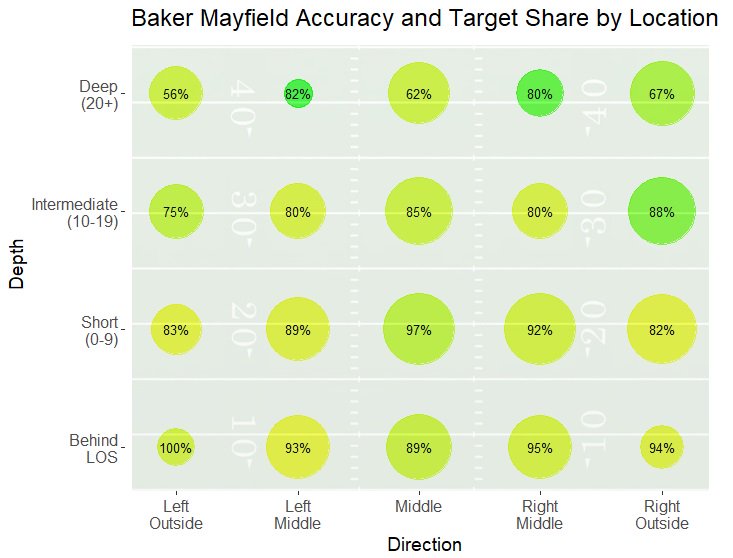By John Shirley
A few weeks ago on this site, we published research showing the effects weather has on a quarterback’s expected completion percentage. Now we will be applying that same question to the running game to see if any weather effects exist.
For this analysis, weather effects on running backs will be analyzed with a few different statistics, including Yards Per Carry, Positive%, and Broken/Missed Tackles. Data used will be from the past two seasons and include only rushing attempts by the road team to help with sampling bias. This results in a data set that includes a little over 11,500 carries.
Dome vs Outdoor
As a first look into weather effects on rushing, lets see how performance is impacted by whether or not the game was played in a covered stadium.
Running Back Rushing Performance of Road Teams by Roof Type (2018-2019)
| Roof Type | Yds / Carry | Avg Yds After Contact | Positive% | BT+MT / 100 Carries |
| Open | 4.3 | 2.6 | 42% | 15.7 |
| Dome | 4.1 | 2.4 | 42% | 14.6 |
By looking at the numbers simply grouped by outdoor games versus games in a dome, it seems there could be a very slight positive benefit to playing outdoors. Running backs had an increase in three of the statistical categories when they were outside, though, Positive% was noticeably unchanged. This is the opposite effect that was seen previously in quarterback performance.
Weather Effects
Similar to the previous research into quarterback performance, we will also look into the role weather plays in rushing performance, if any. The weather variables used will once again be Temperature and Significant Precipitation (defined as any time the precipitation intensity was greater than or equal to 0.25 mm/hr).
As with passing performance being adjusted for other variables such as throw depth and throws outside the numbers, running back rushing performance needs to be adjusted for down, distance, and defenders in the box.
After attempting to model a relationship between the two weather variables and the first two rushing metrics of Yards and Yards After Contact, we found both variables not statistically significant.
However, when modeling a relationship between the two weather variables and Positive%, Temperature becomes statistically significant, albeit with only a marginal impact, even on the season level. Temperature was determined to have a negative relationship with Positive%, meaning that as the temperature increases, the Expected Positive Play Rate decreases.
One way to quantify which performances were most affected is comparing a running back’s Expected Positive% without accounting for weather conditions to a model that includes Temperature as a variable.. The 2019 game which was most positively impacted by the weather was the Bears vs Packers matchup in Week 15. After adjusting for weather, both starting running backs Aaron Jones and David Montgomery had close to a 2% boost in Expected Positive%.
| Player | Week | Expected Pos% | Weather Adjusted Expected Pos% | Difference |
| Aaron Jones | 15 | 37.9% | 40.0% | 2.1% |
| David Montgomery | 15 | 42.2% | 44.2% | 2.0% |
This shows that even though Temperature is a significant variable in the model, even in the most extreme case its impact is relatively small.
Grass vs Turf
Although the field surface type is not a weather variable, we did find it to be an interesting piece when attempting to model a predicted rate for running backs forcing a broken or missed tackle on each individual tackle attempt. The two weather variables were both insignificant in this analysis, but field surface type was found to be a significant variable. This differs from each of the previous models mentioned within this article, in which field surface type did not play a role.
Running backs attempting to force a broken or missed tackle have a higher success rate of doing so on grass fields rather than turf fields. This is somewhat shown in the first table, where outdoor stadiums had a higher Broken+Missed Tackles / 100 Attempts. But it doesn’t tell the whole story, as a stadium’s roof type is not the deciding factor. A stadium’s field surface type seems to be the actual factor providing the difference. Though, this research is currently limited by a binary classification of field surface type, when in reality there are multiple different types of turf and grass being used in the NFL.
Overall Findings
- Temperature and Precipitation are NOT significant variables when trying to predict Rushing Yards, Rushing Yards After Contact, or Broken+Missed Tackle Rate.
- Temperature IS statistically significant when predicting Rushing Positive%. This results in running the ball being slightly more efficient in cold weather. Though, the overall impact is relatively small, even in the most extreme cases.
- The field’s surface type IS a factor in forcing broken and missed tackles, where it is easier to do so on grass than turf. Though, this too has a relatively small impact overall.
- Overall, weather and the field’s surface type have limited impacts on rushing offense.

